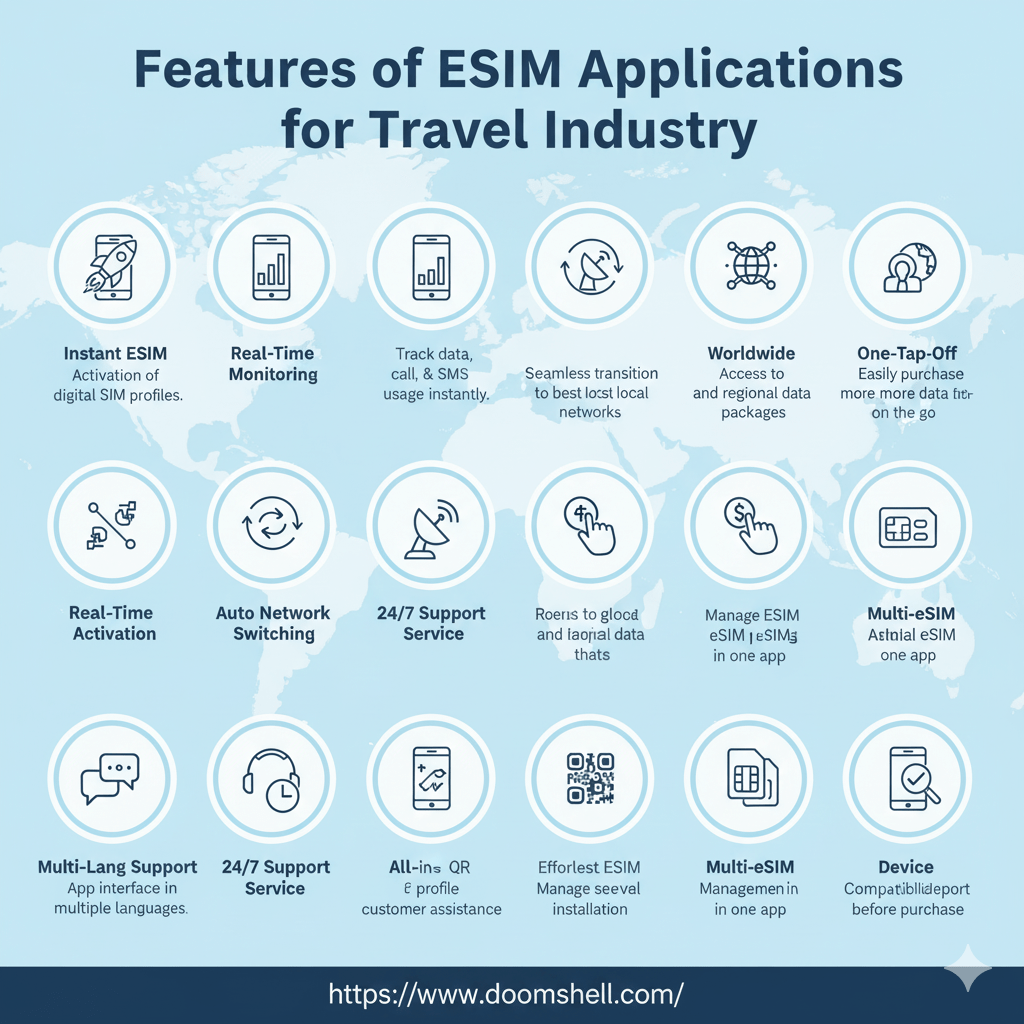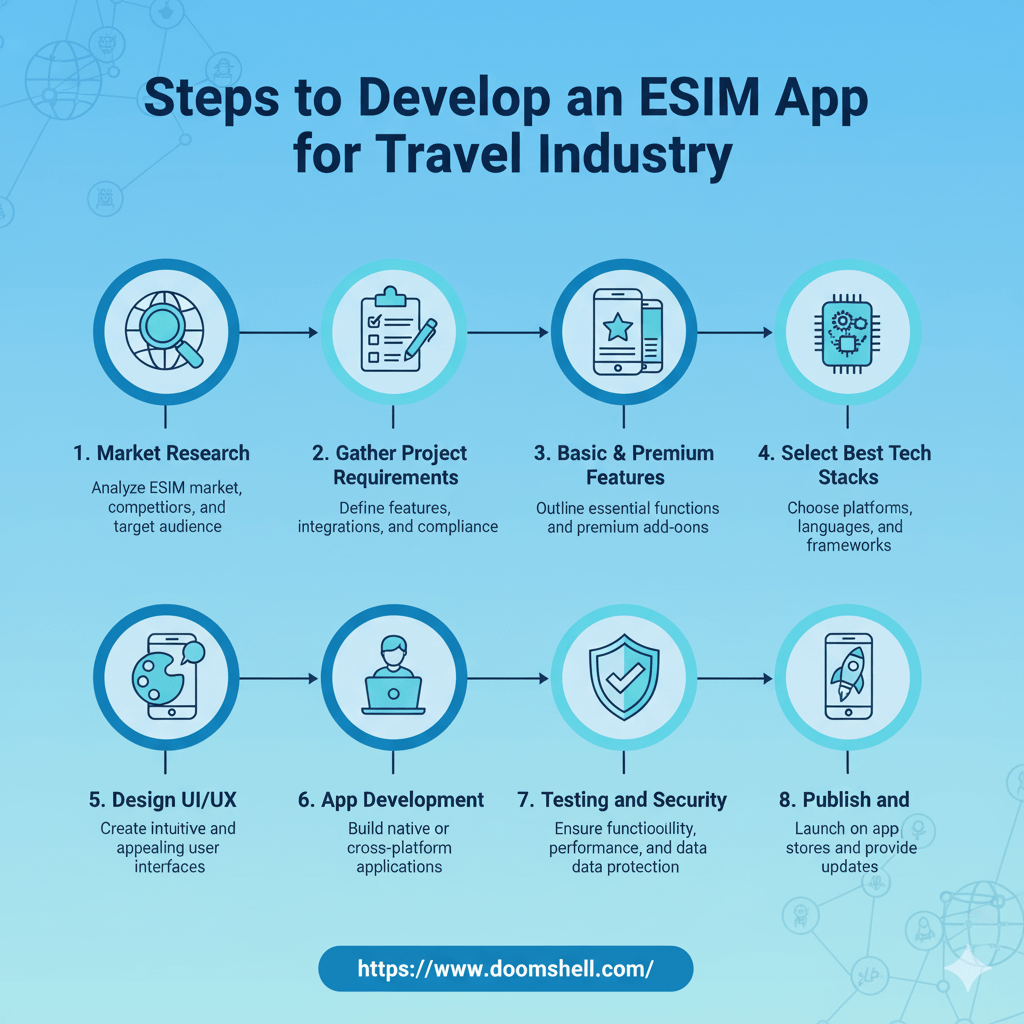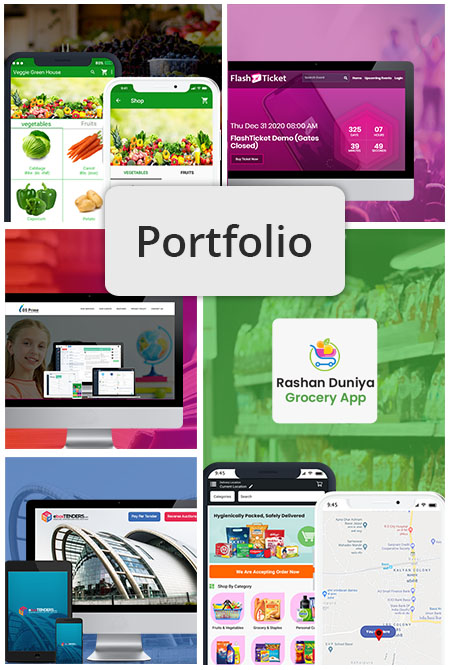Key Takeaway
- eSIM Applications eliminate the need for physical SIM cards, allowing for instant activation and global coverage.
- They are also tapping into a growing travel market with ongoing revenue potential.
- AI features provide smart recommendations, usage monitoring, and real-time assistance.
- It reduces operating costs and provides for swift scaling while providing a high-quality service.
- You can generate revenue via subscriptions, freemium formats, advertising, and partnerships with telecommunications companies.
Picture this: you land in a new destination, and in just a few moments, you have connected to a local mobile network. No busy airport kiosks, no SIM cards flying out of your purse, just seamless connectivity.
This is eSIM technology, which is revolutionizing the travel industry.
As global travelers look for more convenience and flexibility, eSIM apps are becoming a necessity for remaining connected beyond home markets.
How do you design and develop an eSIM app that meets the needs of the modern explorer? The process can be complex, due to regulatory concerns and UX design, yet is incredibly enjoyable.
We’d like to take a closer, deeper look at the key steps to creating a successful, user-friendly eSIM application for the travel market. The eSIM app should help users easily switch networks, manage data plans, and travel the world without the limitations of a traditional SIM card. Let’s dive in.
Global Market Projections of eSIM Applications
- In 2024, the eSIM apps industry is valued at approximately $10.32 billion, with an upward trend to about $17.67 billion toward the end of 2033.
- North America takes the largest revenue share of the eSIM apps market at an estimated 42.8% in 2024.
- In terms of solutions, the section for connectivity services occupies the highest market segment at about 87.5% in 2024.
- The eSIM applications market is expected to grow at a CAGR of 5.1% between 2025 and 2033, according to extensive research.
- When looking at applications, we see that the M2M segment leads the eSIM market and captures the biggest revenue share in 2025.
What is an eSIM App?
An eSIM application is an application that permits a user to buy data plans digitally without a physical SIM and enables a seamless connection.
An eSIM application functions as a virtual SIM and some applications also allow for a second number for phone calls and text messages, whether it be for business or personal use. This mobile application medium can allow multiple SIMs for multiple uses and allow users to switch them out as desired.
1. Growing Global Travel Market: As international travel regains its vitality, demand for seamless connectivity rises. eSIM apps provide immediate access to local networks and assist travelers in avoiding roaming fees to stay connected while traveling. Therefore, this is a viable value opportunity for businesses targeting technology savvy, global consumers.
2. Recurring Revenue Potential: Through eSIM applications, customers can subscribe or purchase a data plan. This subscription model creates a recurring revenue stream, developing sustainable profit opportunities for companies by enabling them to monetize user engagement on an ongoing basis, instead of relying solely on one-time purchases or app downloads.
3. Low Operational Overhead: Compared to a physical SIM, eSIM apps remove the logistics, inventory, and manufacturing expenses. Companies can expand faster and be less resource-intensive by digitalizing while still protecting margins while delivering high-quality mobile telecommunications services on behalf of their customers around the world.
4. Enhanced User Experience: The creation of eSIM on demand app solutions provides an easy way to experience this digital convenience without switching a physical SIM card or requiring a store visit. This digital convenience will help drive satisfaction and build loyalty, while meeting customer expectations in a mobile-first world, and especially among digital nomads and customers who frequently travel.
5. Early Mover Advantage: The eSIM landscape is still developing. By investing early, companies can grow their market presence, establish brand authority, and innovate ahead of competition–and position themselves as one of the leaders in an evolving ecosystem for digital connectivity experiencing rapid growth.
Why Build an eSIM App?
Growing travel demand — More people are travelling and want seamless internet without roaming hassles.
Recurring revenue—Users will keep buying data plans, so you get repeated income, not just one-time sales.
Lower costs—no need for physical SIM cards or shipping/distribution. Everything is digital.
Better user experience — No more swapping SIMs, going to shops, etc. It’s more convenient.
First-mover advantage—The market is still evolving, so early businesses can stand out.
Role of AI in eSIM Applications?
- Artificial intelligence assesses location, speed, and signal quality to instantly link users to the best available network.
- Artificial intelligence identifies usage behavior and travel patterns to recommend the most appropriate and cost-effective data plans.
- Artificial intelligence chatbots provide instant, accurate, and reliable assistance to drive down support costs and improve user satisfaction and trust.
- Artificial intelligence monitors usage behavior to detect suspicious activity and mitigate risks related to identity theft and account take-over of eSIM accounts.
- Artificial intelligence uses geolocation data to deliver region specific offers, content, and updates directly through the eSIM app.
Steps to Develop an eSIM App for Travel Industry
To create an eSIM app, you will need to focus on the basic and advanced requirements and integrate the customized features to increase user engagement. Follow the development steps that guide perfectly and lead to successful app development. So, let’s explore the eSIM app development process:
- Market Research
- Gather Project Requirements
- Basic & Premium Features
- Select Best Tech Stacks
- Design UI/UX
- App Development
- Testing and Security
- Publishing and Maintenance
1. Market Research: To get started with your eSIM app project, conduct preliminary market research to understand the current industry trends and successes with eSIM applications. You may also want to look at how existing eSIM applications are structured, what services they offer, and how they function to compare the service and processes for your application.
2. Gather Project Requirements: Let’s initiate the second stage in the process of creating an eSIM app and commission consulting experts with a strong background in a travel app development company to collect our project’s basic and advanced needs. In addition to recording content in these meetings, ask the consultants to assist with providing a clear and organized chart along with our needs to eliminate redundancy and miscommunication.
3. Basic & Premium Features: In the third stage of developing a travel eSIM application, select the basic and advanced features that you will include in the application. It has various features, such as carrier switching, managing digital SIM cards, virtual numbers, and features for security & privacy, as well as international data & roaming.
4. Select Best Tech Stacks: The fourth step in the process of building an eSIM application is choosing the technology stacks. The technology stacks are an essential component of every mobile app development service. A technology stack consists of a combination of technologies such as frontend & backend development, designing tools, testing, database, cloud storage, etc.
5. Design UI/UX: As we move on to step five of eSIM app development for telecom, let’s design a user interface with a unique visual style. This includes various UI components such as layouts, templates, forms, wireframes, prototyping, themes, fonts, styles, colors, and plugins.
6. App Development: Begin the actual coding, by recruiting skilled programmers from a GPS tracking application’s development company. Implement third-party integrations for instances such as payment gateways, social media logins, communication tools, analytics, CRM, ERP, and others. Ensure that all the third-party tools and applications have been properly integrated.
7. Testing and Security: Advance to the penultimate phase of developing an eSIM application, by assessing the app under a range of methodologies including application testing, unit testing, integration testing and more. Then, enforce security measures like encryption methodologies, two-factor authentication and biometrics.
8. Publish and Maintenance: To go live with the app, consider hiring a reputable web app development services provider to set forth with assurance that all elements of deployment are properly and successfully integrated. After the launch, maintenance services such as periodic backups, design improvements, fixing glitches or bugs, and optimization of performance should be conducted.
Features of eSIM Applications for Travel Industry
1. Instant eSIM Activation: Travelers can activate the eSIM instantly and connect without the need to visit physical stores by using the eSIM applications.
2. Real-Time Usage Monitoring: The multi-network eSIM application provides daily monitoring of data usage to avoid overages and spectrum use.
3. Auto Network Switching: The travel connectivity application automatically switches to the best available network to allow reliable connectivity between different countries.
4. Worldwide Coverage Plans: The digital eSIM card application presents an array of coverage plans that provide easy access to multiple destinations and offer seamless connectivity.
5. One-Tap Top-Off: The eSIM application for travel provides users with a one-tap option for data renewal or top-off while traveling and allows them to switch devices.
6. Multi-Lang Support: An eSIM activation application offers support for multiple languages, and users can modify the language of the application in accordance with their suitability and requirements.
7. 24/7 Support Service: An eSIM application like Daily provides 24/7 customer support service that will follow up with the customers’ raised concerns and immediate resolution.
8. All-in-One QR Code Scanning: This feature delivers the benefits of eSIM for travelers, enabling travelers to scan a QR code for fast eSIM provisioning and no manual setup.
9. Multi-eSIM Management: The eSIM for international travel provides the advantage to users to swap and manage multiple eSIMs, and it is helpful for regular travelers.
10. Device Compatibility Check: Benefits of eSIM technology for travel apps include checking the device compatibility to use eSIM and particular networks.

The Cost to Build an eSIM App
The estimated cost to develop an eSIM application will range from $8,000-$25,000 based on specific needs and requirements. There are several factors that will impact the cost such as complexity, features, functions, backend infrastructure, deployment platforms, and the development team. The factors can influence the cost and change the total project budget. The cost table below provides costs in detail:
| Tier | Included Features | Estimated Cost (USD) |
| Basic MVP | User login, plan listing, QR code activation, basic UI | $8,000 – $10,000 |
| Standard MVP | Real-time usage tracking, multilingual support, and payment integration | $10,000 – $13,000 |
| Feature-Rich MVP | Plan comparison, customer support chat, and offline install instructions | $13,000 – $16,000 |
| Multi-Region App | Global coverage, multi-eSIM support, auto network switching | $16,000 – $18,000 |
| Business-Ready Version | Loyalty/referral programs, local number support, push notifications | $18,000 – $22,000 |
| Premium Version | Backup/restore, itinerary integration, advanced UI/UX, compliance | $22,000 – $25,000 |
How to Generate Revenue From eSIM Applications?
Building a mobile application for eSIM is a fantastic idea for the same reasons mentioned earlier, but monetizing an app is the hardest part. Check out the different monetization strategies listed below, and incorporate them into your application.
1. Commission-Based Partnerships
Telecom companies worldwide partner with eSIM applications and earn commissions for every allocation that the users transact through the application. Several different commissions can be charged, perhaps in the 8% to 12% range. This is another monetization strategy that allows companies to take advantage of new revenue streams.
2. Freemium Model
Some eSIM solutions in the travel space are with limited/basic features to users for free. If the user wants to access the premium features or any additional features, then users would need to purchase them or subscribe to a subscription plan. According to the travel applications development provider, it can also help create another revenue stream and add value to the company.
3. In-App Advertising
eSIM technology applications in travel sell an ad space for businesses/organizations to post an ad on the eSIM service. Companies charge an acceptable fee for every ad posted on the application. Many different advertising formats can be offered, such as a banner ad, native ad, image ad, display (which can be an advertisement, animated, or combination of video and advertising) ad can be developed to engage users.
4. Membership Plans
For users to gain unlimited access to the app, the eSIM apps offer paid membership plans. These plans include basic plans, premium plans, and enterprise plans. Users pay either monthly or annually for premium or enterprise plans.
Conclusion on eSIM Application
In this blog, we discussed how to create an eSIM app for the travel business and why eSIM apps are flourishing in the market. We believe that you have wiped out all your confusion and doubts about the eSIM app creation for the travel business.
Do you want to create an eSIM app? Then what are you waiting for? Just reveal your project’s bespoke requirements to a successful mobile application development company in USA to avail the solution at a reduced price.
Frequently Asked Questions About eSIM Application
Q1. What is the Cost of eSIM App Development in the Travel Sector?
The price of developing an eSIM application ranges from $8,000 to $25,000 or more. The cost of eSIM app development can be influenced by specific factors, including the application size and complexity, features, backend infrastructure, development team, and tech stacks.
Q2. How Long Will It Take to Develop an eSIM App for Travel?
The eSIM application development timeline can vary but is approximately 6 to 15 weeks. It usually takes this long because of different factors, like complexity, size, number of features, and the number of hours the developers will work.
Q3. Which Technology is Used to Develop an eSIM App for Travel?
Here we provide a list of technologies to develop an eSIM app:
- Java
- Python
- C++
- C#
- PHP
- Flutter
Q4. What Devices/Platforms Support eSIM?
Here is the list of devices that support eSIM :
- Newer iPhone devices (iPhone XS and later)
- Samsung Galaxy S20 or newer versions
- Google Pixel devices
- Apple Watches, iPads, Windows, etc.
Q5. What Are The Major Roadblocks To Building An eSIM App?
- Device and OS fragmentation
- Creating a secure and seamless user experience
- Integration with various complex telecom APIs
- Ensuring regulatory compliance
- High cost and development time.
Also Read
How Much Does It Cost to Build a Laundry App Development in 2025?














































